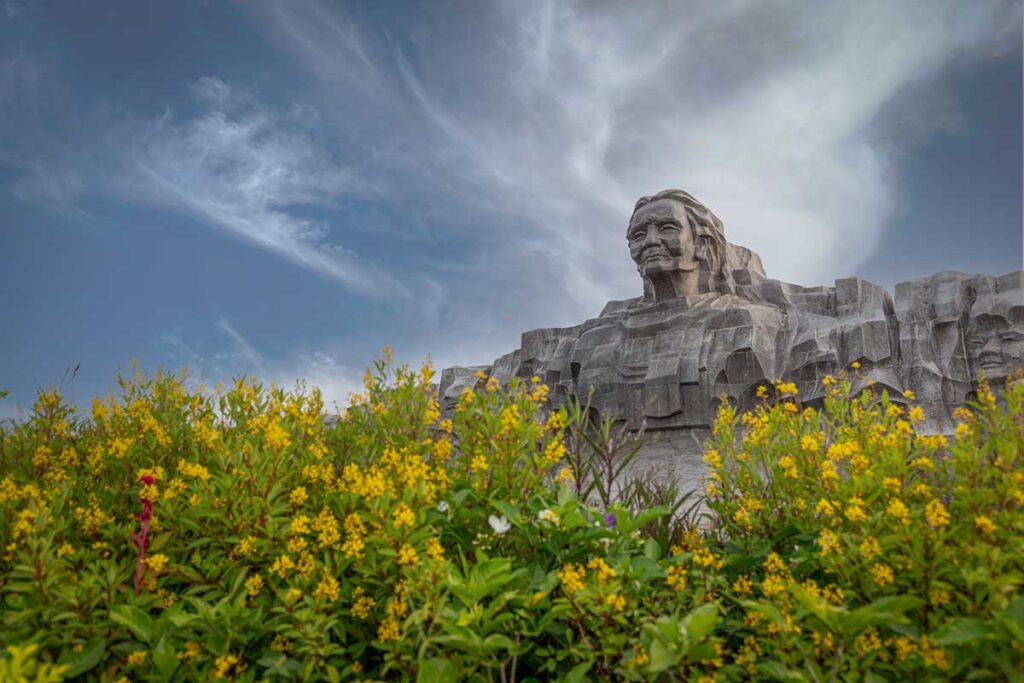What is Vietnam’s Heroic Mother Statue?
Vietnam’s Heroic Mother Statue is a modern national memorial built on the slope of Cam Mountain in Tam Ky, Quang Nam. It was created to honor women who were awarded the title “Heroic Vietnamese Mother,” given to those who lost children or family members in war and made extraordinary sacrifices for the country’s independence.
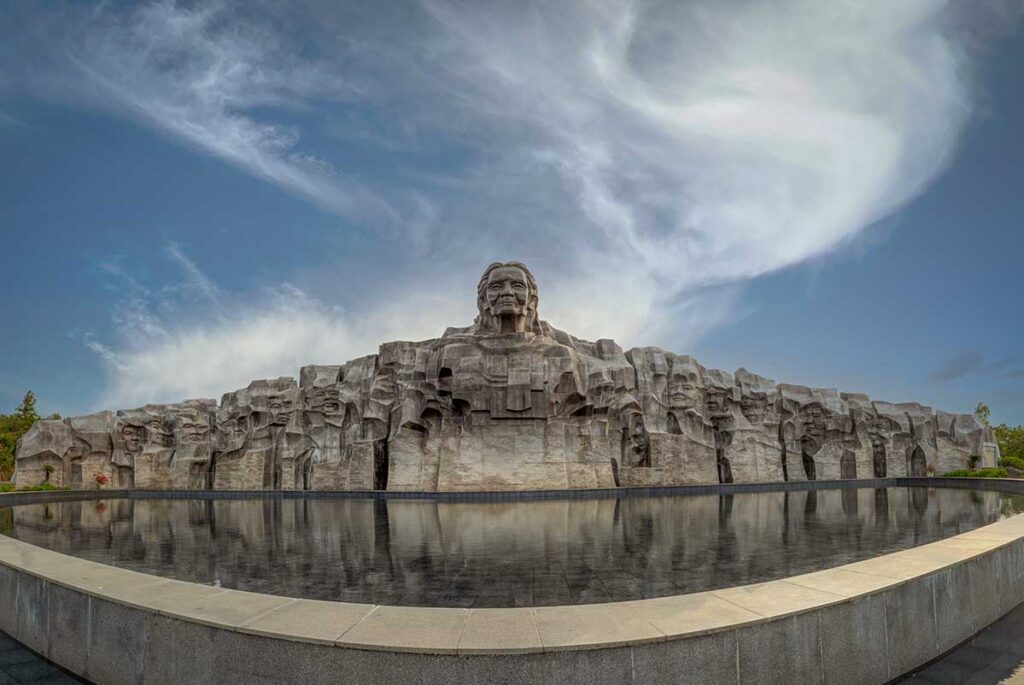
The monument is monumental in scale and design — shaped like a mountain rising from the landscape, with smooth lines symbolizing strength and motherhood. The statue itself stands about 18 meters high and spans roughly 117 meters wide, set within a large park that covers around 15 to 16 hectares.
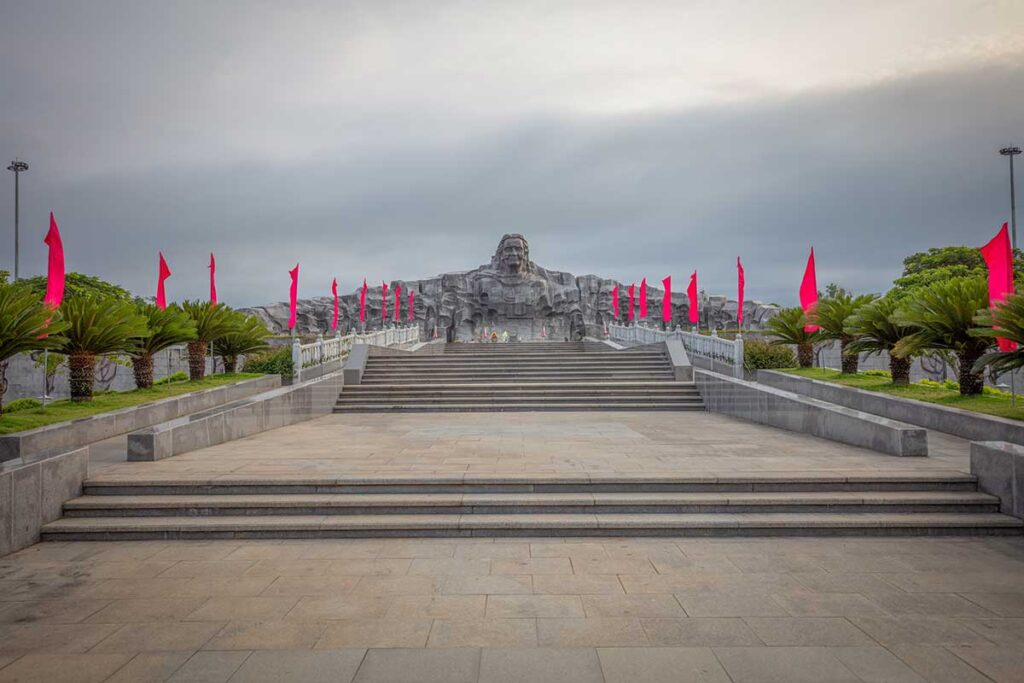
When you arrive, you’ll see the large central figure of the mother carved from stone, flanked by eight tall pillars at the front square. These pillars are engraved with images of Vietnamese women from different regions and wartime volunteers. The setting includes a wide open plaza, landscaped lawns, and a few shaded pavilions for resting. Inside the structure, there is a small museum displaying photographs and stories of heroic mothers across the country, although it’s not always open to visitors.
Built as a place of remembrance rather than tourism, the statue serves as a symbol of wartime sacrifice and maternal endurance, representing both national gratitude and quiet reflection.
The story of Mother Thu & Vietnam’s “Heroic Mothers”
The face of the statue is modeled after Mother Nguyen Thi Thu, known in Vietnamese as Me Thu, a woman from Quang Nam who became a national symbol of sacrifice. During the wars, she lost her husband, nine sons, one son-in-law, and two grandsons — nearly her entire family. Her story embodies the suffering and resilience of thousands of Vietnamese women who endured similar loss, earning her the title of a “Heroic Vietnamese Mother.”
Across Vietnam, around 50,000 women have been officially recognized with this honor, each representing quiet courage and devotion to the country’s independence. The statue, therefore, is not just a portrait of one woman but a tribute to all heroic mothers who carried the emotional and personal weight of Vietnam’s wars.
Quang Nam was chosen as the site because it has one of the highest numbers of recognized heroic mothers in the country. The monument’s location on the gentle slope of Cam Mountain was meant to express both permanence and humility — a place for reflection rather than spectacle.
The symbolism is deeply woven into the design. The mountain-like shape represents maternal strength, protection, and endurance. The eight tall pillars in front are carved with images of women from the north, central, and southern regions, along with young female volunteers, and are often interpreted as symbols of unity, peace, and traditional virtues such as bravery and gentleness.
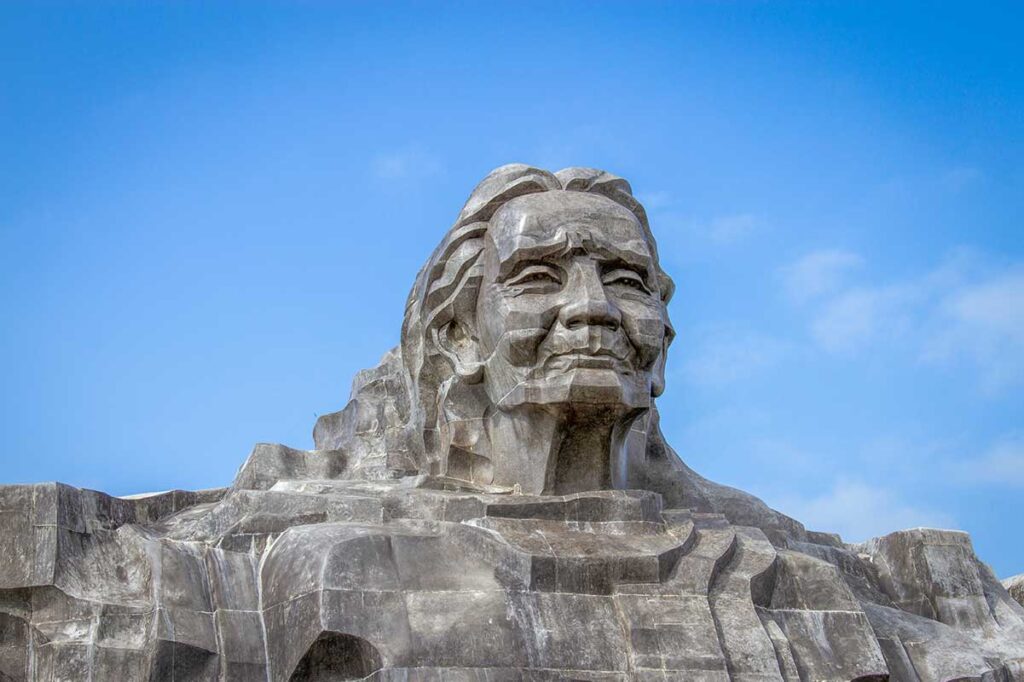
The statue was designed by painter Dinh Gia Thang and executed by architect Nguyen Luan, using massive granite blocks. The result is a solemn, powerful structure — more about presence and meaning than artistic ornamentation.
Highlights of visiting Vietnam’s Heroic Mother Statue
Visiting Vietnam’s Heroic Mother Statue is more about quiet reflection than sightseeing. The complex is vast and open, dominated by stone, sunlight, and silence. Most travelers spend 20 to 45 minutes here, sometimes longer if the interior museum happens to be open. It’s a meaningful stop if you’re passing through Tam Ky or visiting nearby Tam Thanh, but not a place to fill an entire afternoon.
1. Walking the main plaza & eight pillars
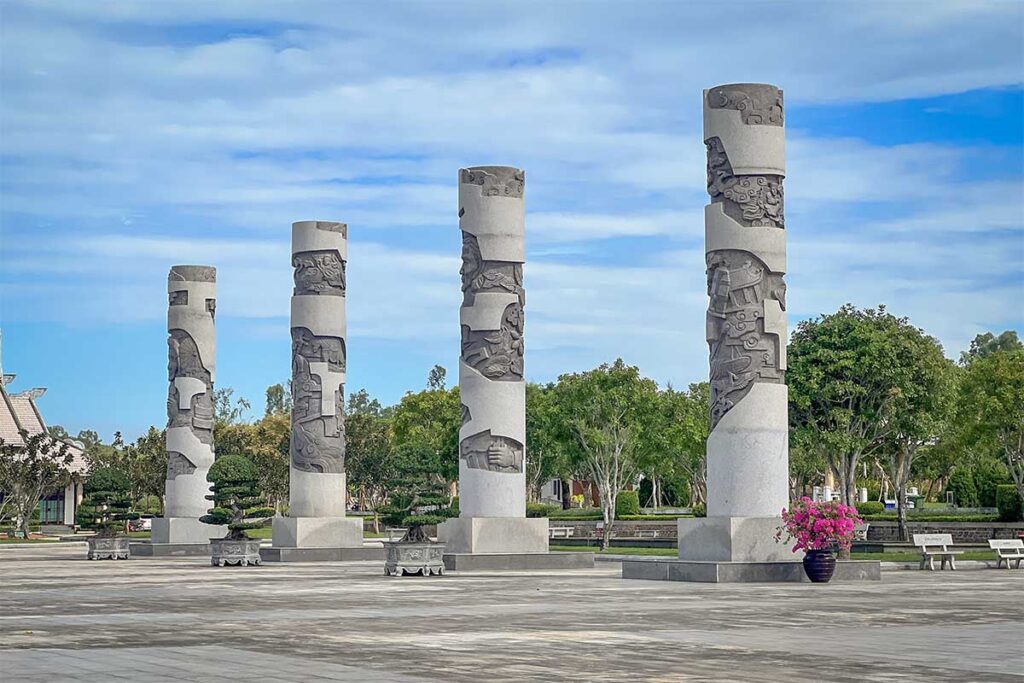
The approach to the monument begins with a wide, empty square leading up to the massive stone figure. On both sides stand eight tall pillars, each about eleven meters high, carved with scenes of women and young female volunteers from Vietnam’s wartime history.
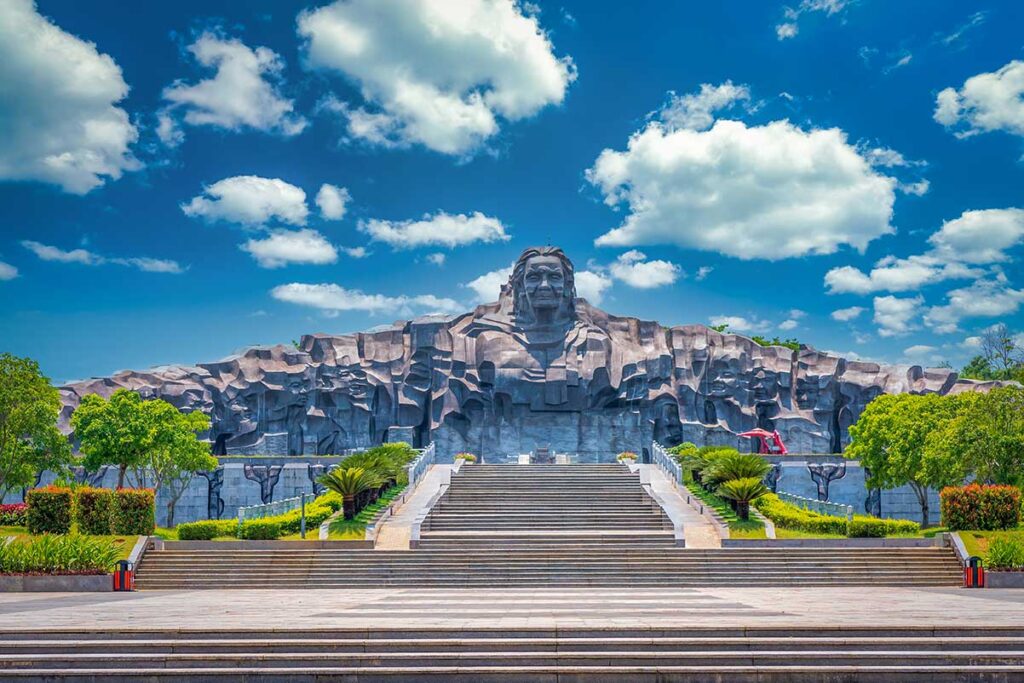
From the plaza, you can sense the monument’s enormous scale — the mother’s calm face rising from the mountain-like structure behind her, framed by open sky and hills.
2. Interior commemorative museum (if open)

Inside the base of the statue is a small commemorative room that holds photographs, names, and short stories of heroic mothers from across Vietnam. The displays are simple but powerful, showing personal histories behind the national symbolism. However, the museum is not always open; it often remains locked outside of special days or official ceremonies, so don’t plan your visit around it.
3. Landscaping, lake & quiet corners
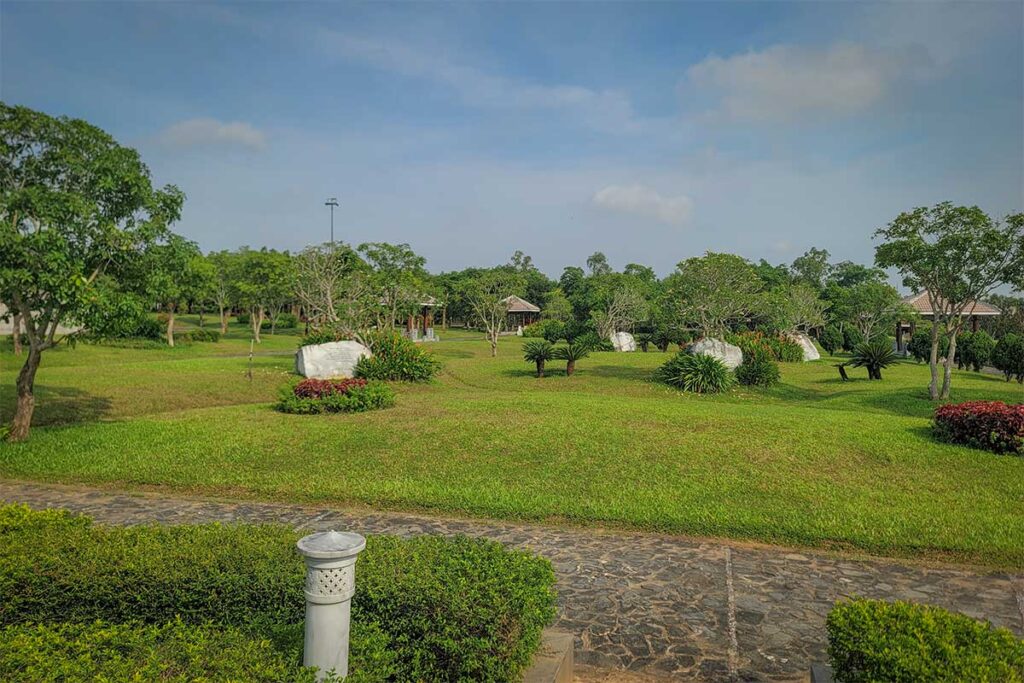
Around the main monument are landscaped gardens, a small lake, and several shaded pavilions that offer places to sit and rest. The area is clean and peaceful, with little traffic or noise — ideal for a short break or quiet contemplation. It’s a space that invites you to slow down rather than explore.
4. Quang Nam Martyrs Cemetery next door

Just beside the statue lies the Quang Nam Martyrs Cemetery, where tens of thousands of soldiers from the province are honored. Visiting both sites together helps put the monument into perspective — the statue symbolizes the mothers, while the cemetery represents the sons they lost. It’s a solemn and meaningful add-on for those interested in Vietnam’s wartime history. Remember to keep your voice low and behave respectfully when walking through the grounds.
Location & Getting there
Where is Vietnam’s Heroic Mother Statue?
The Vietnamese Heroic Mother Statue is located in Tam Phu Commune, on the lower slope of Cam Mountain, about 5 to 7 kilometers from Tam Ky City Center in Quang Nam Province. The drive from Tam Ky takes around 10 to 15 minutes.
For most travelers, Tam Ky serves as the practical base for visiting. It’s a small provincial city connected by the coastal road that runs between Hoi An, Da Nang, and Chu Lai. The distance is roughly 45 to 65 kilometers from Hoi An or Da Nang, and Chu Lai Airport is the nearest airport if you’re flying in. Getting to Tam Ky is straightforward by car, taxi, or motorbike.
Taxi or ride-hailing service
From Tam Ky, it’s easy to reach the monument by taxi. However, you should ask the driver to wait while you visit, since taxis rarely pass by the site for return pick-ups. Ride-hailing apps may not always be reliable here.
If you’re coming from Hoi An or Da Nang, a taxi or private transfer is possible but relatively expensive for such a short visit, so it’s best planned as part of a longer day trip.
Car with driver
Hiring a car with driver is the most convenient option if you plan to combine several stops, such as Tam Thanh Mural Village, the Ky Anh Tunnels, or nearby coastal viewpoints. You can travel at your own pace, avoid worrying about return transport, and the driver will wait while you explore each stop. It’s also a good way to experience the quiet coastal scenery along the way.
Renting a motorbike
For a more flexible and budget-friendly option, you can rent a motorbike in Tam Ky or even ride down from Hoi An. The roads are generally flat and easy to follow but mostly exposed with little shade, so bring sun protection.
Practical notes: fuel up in town, as rural stretches have few gas stations; always wear a helmet and carry water. Officially, you need a valid home license plus an International Driving Permit (IDP) for insurance coverage, even though many local rental shops don’t ask for it.
Practical visiting information & travel tips
Entrance & costs
Access to the Vietnamese Heroic Mother Statue is free of charge, and there’s no ticketing for the outdoor areas. The interior museum beneath the statue, when open, is also free or occasionally requests a small symbolic donation. Since the museum isn’t open daily, it’s best to view it as an optional bonus rather than a guaranteed part of your visit.
Opening hours & access pattern
The grounds are open all day, and there are no gates or entry restrictions. You can visit at any time, though the atmosphere feels most meaningful in daylight. Evenings are quiet but may have limited lighting, so it’s not ideal after sunset. The small commemorative room inside is usually locked and only opened on special occasions or holidays.
Best time to visit
The site is extremely exposed to the sun, with a large open plaza that reflects heat. It’s most comfortable to visit in the early morning or late afternoon, when the light is softer and temperatures are lower. Around midday, it can get uncomfortably hot and bright, with almost no shade to stand under.
What to bring
Bring a hat, sunscreen, and plenty of water, especially on sunny days. Comfortable walking shoes are helpful for the long plaza and steps. During the rainy months, an umbrella or light rain jacket is useful, and carrying a small snack is smart as there are no cafés nearby. A camera or phone with a wide lens works well for capturing the monument’s large proportions.
Facilities on site
Facilities are very limited. There are no cafés, souvenir stalls, or air-conditioned spaces. A few shaded pavilions and trees offer rest areas, and there are basic public toilets, but maintenance can vary. It’s best to treat this as a short stop, not a place to spend extended time.
Etiquette at a memorial
This is a place of remembrance, not a tourist attraction. Dress modestly, keep your voice low, and avoid standing or climbing on sculptures. Be discreet with photography, especially if local visitors are paying respects or making offerings.
Time needed
Most visitors spend 20 to 45 minutes at the site, or up to an hour if you explore the interior exhibits when open. The main experience is simple — walking, observing, and reflecting — so it fits easily into a half-day itinerary around Tam Ky.
What is nearby to combine a visit
Since the Vietnamese Heroic Mother Statue is more of a short stop than a full destination, it fits best as part of a broader itinerary around Tam Ky or the nearby coast. The area offers a mix of cultural sights, wartime history, and quiet coastal scenery — all within short driving distance. Here are some worthwhile places to combine in the same day.
Tam Thanh Mural Village
Only about 15 minutes from the statue, this small fishing village is covered in colorful wall paintings created by local and Korean artists. The murals depict daily coastal life and folklore, and the atmosphere is relaxed with a few seaside cafés and homestays. It’s the most common add-on after visiting the monument.
Ky Anh Tunnels
Located just outside Tam Ky, the Ky Anh Tunnels offer an underground glimpse into wartime life. The tunnels were used by local fighters for shelter and transport, and the visit includes short walks through reconstructed passages. It’s a more immersive historical stop compared to the symbolic tone of the Heroic Mother Statue.
Cham Towers (Chien Dan / Khuong My)
For history lovers, these small Cham ruins near Tam Ky date back almost a thousand years. The structures are modest but interesting for those exploring the remnants of the ancient Champa Kingdom. They’re quiet sites with little infrastructure but easy to combine on the way toward Tam Thanh or the highway.
Tam Thanh Beach & the coastal road
If you’re in the mood for open views, continue south along the coastal road connecting Tam Ky to Chu Lai. Tam Thanh Beach itself is long, simple, and mainly used by locals. It’s not a developed resort beach, but it’s a pleasant stop for fresh air and sea views.
Tam Hai Island (full-day loop)
For something more offbeat, you can extend the trip with a ferry crossing to Tam Hai Island, known for its fishing villages and mural-covered houses. The beaches are quiet and natural rather than picture-perfect, but the journey — especially the coastal drive and ferry — can be enjoyable for those who like local experiences.
Local markets / Tam Tien Fish Market
If you start early, consider a visit to the Tam Tien Fish Market, held at dawn on the beach. It’s busy, authentic, and full of color, but it only makes sense if you’re already in the area early in the morning. Otherwise, Tam Ky’s central market offers a smaller and more convenient local experience.
Is Vietnam’s Heroic Mother Statue worth a visit?
If you’re interested in Vietnam’s wartime history or want to understand how the country honors its heroes, the Vietnamese Heroic Mother Statue can be a meaningful stop. For Vietnamese visitors, it’s a place of pride and remembrance, deeply tied to family and national memory. For foreign travelers, however, it’s more of a symbolic landmark than an engaging attraction.
The monument is undeniably impressive in size and craftsmanship, but there’s little to “do” beyond walking around, reading the few signs, and taking in the quiet atmosphere. The heat and lack of shade also make it a brief visit rather than a leisurely one.
In short, it’s worth visiting as part of a wider itinerary — especially when combining it with Tam Thanh Mural Village or the coastal drive. It offers a glimpse into Vietnam’s sense of remembrance and sacrifice, but on its own, it’s unlikely to be a highlight of your trip.
